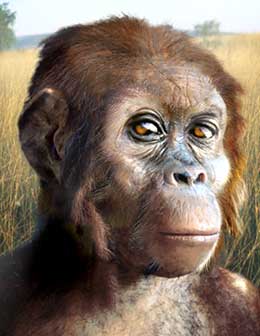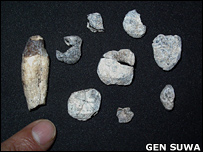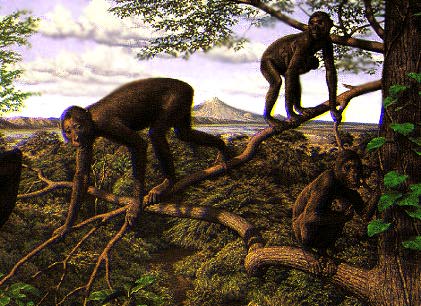New Unknown Fossil Great Ape
Posted by: Loren Coleman on August 23rd, 2007

To many, the reconstructions of Lucy (above) and other Australopithecus species appear to look rather apelike.
However, until recently, fossil finds for the ancestors of the great apes have been lacking. That all seems to be changing. The nine fossil teeth (below) from Ethiopia are being announced in Nature, as gorilla-like and said to be from a previously unknown species of great ape.

Here’s more from the BBC:
The 10 million-year-old fossils belong to an animal that has been named Cororapithecus abyssinicus by the Ethiopian-Japanese team.
This new species could be a direct ancestor of living African great apes, say the researchers.
The finds from the Afar rift, in eastern Ethiopia, raise questions on current theories of human evolution.
The researchers say the fossils from Ethiopia probably belonged to an ape from the gorilla family.
Evolutionary divide
Based on genetic evidence, gorillas and humans were thought to have split away from a common ancestor about eight million years ago.
The 10 million-year age of the fossils led the research team to suggest that the split must have happened earlier than 10.5 million years ago.
If correct, molecular and DNA studies will need to be revisited.
The fossils were found at a site in eastern Ethiopia’s Afar rift
The team’s claims that the teeth belong to a member of the gorilla family stem from similarities with teeth of modern gorillas.
They carried out cutting-edge 3D analysis of the molar tooth’s structure and found that both gorillas and the new species had a unique specialisation for eating fibrous foodstuffs such as stems and leaves.
“It’s a subtle distinction, but we’ve compared it with everything we could think of,” said Dr Suwa from The University of Tokyo, and a member of the research team.
“And it does show some telling signs of gorilla-like molar structure. If it’s not a gorilla relative, then it’s something very similar to what an early gorilla must have looked like.”
Vegetarian tastes
Gorillas are unique among modern and fossil large-bodied apes in having molars that are specialised for shredding fibrous vegetation. The reason for this is that large-bodied gorillas depend on stems and leaves as an important part of their diet.
Not everyone agrees with the teams conclusions, however. Professor Peter Andrews, from London’s Natural History Museum, commented: “It is stretching the evidence to base a time scale for the evolution of the great apes on this new fossil.”
Professor Andrews believes the structures found on the teeth could be related to the diet of the animal.
He added: “These structures appear on at least three independent lineages of apes, including gorillas, and they could relate to a dietary shift rather than indicating a new genetic trait.”
Fossil record
What is not in doubt is that is that the find itself is impressive.
“The ancestry of humans is increasingly well known, but the fossil evidence for the evolution of our closest living relatives, the great apes, is almost non-existent,” Professor Andrews explained.
“It is really exciting therefore to find a fossil ape from this time period – about 10 million years ago – since there is only one other fossil ape known from this time, the more complete Samburupithecus.”
The find also supports data that suggests Africa was the origin of both humans and modern African apes.
The teeth were discovered in a region called the Afar rift in Ethiopia, about 170km (106 miles) east of Addis Ababa.
In an area of the Oromiya National Regional State, there are exposed patches of sediments that are 10 to 11 million years old, from the Miocene era, which are known as Miocene Chorora Formation.
The name of the ape is taken from the geological formation Chorora and the former name of Ethiopia, Abyssinia. “Fossils belong to new great ape,” by Liz Seward, BBC News, 22 August 2007.

Proconsul is one of the earliest fossil apes.
About Loren Coleman
Loren Coleman is one of the world’s leading cryptozoologists, some say “the” leading living cryptozoologist. Certainly, he is acknowledged as the current living American researcher and writer who has most popularized cryptozoology in the late 20th and early 21st centuries.
Starting his fieldwork and investigations in 1960, after traveling and trekking extensively in pursuit of cryptozoological mysteries, Coleman began writing to share his experiences in 1969. An honorary member of Ivan T. Sanderson’s Society for the Investigation of the Unexplained in the 1970s, Coleman has been bestowed with similar honorary memberships of the North Idaho College Cryptozoology Club in 1983, and in subsequent years, that of the British Columbia Scientific Cryptozoology Club, CryptoSafari International, and other international organizations. He was also a Life Member and Benefactor of the International Society of Cryptozoology (now-defunct).
Loren Coleman’s daily blog, as a member of the Cryptomundo Team, served as an ongoing avenue of communication for the ever-growing body of cryptozoo news from 2005 through 2013. He returned as an infrequent contributor beginning Halloween week of 2015.
Coleman is the founder in 2003, and current director of the International Cryptozoology Museum in Portland, Maine.










According to New Scientist, this has a pretty huge impact on our evolutionary history: http://www.newscientist.com/article.ns?id=mg19526182.500&feedId=online-news_rss20
(Only a partial bit of the article for non-subscribers, but still packs a punch… as much as a 4 million year shift in our line of divergence!)
hey loren very infomative new article about a new unknown fossil great ape. thanks bill green
How can they do any tests on those teeth? They look like they are going to fall apart if anyone sneezes. And why can’t thee scientists just say, “We found teeth” and leave it to that. Why must they try to insert every ancient primate into our ancestry? Teeth again, will we ever learn?
I’m sure the scientists are experienced with testing fragile fossil teeth.
But “when will we ever learn” what? Scientists don’t try to put every ancient fossil primate into our ancestry. For example Sivapithecus, ancestor of orangutans, is not in our ancestry. Neither is the enigmatic Miocene ape Oropithecus. Then there are the dozens of other fossil apes which are not considered ancestral to us, not to mention the numerous monkey, tarsier and lemur fossils, few of which are considered to be in our line.